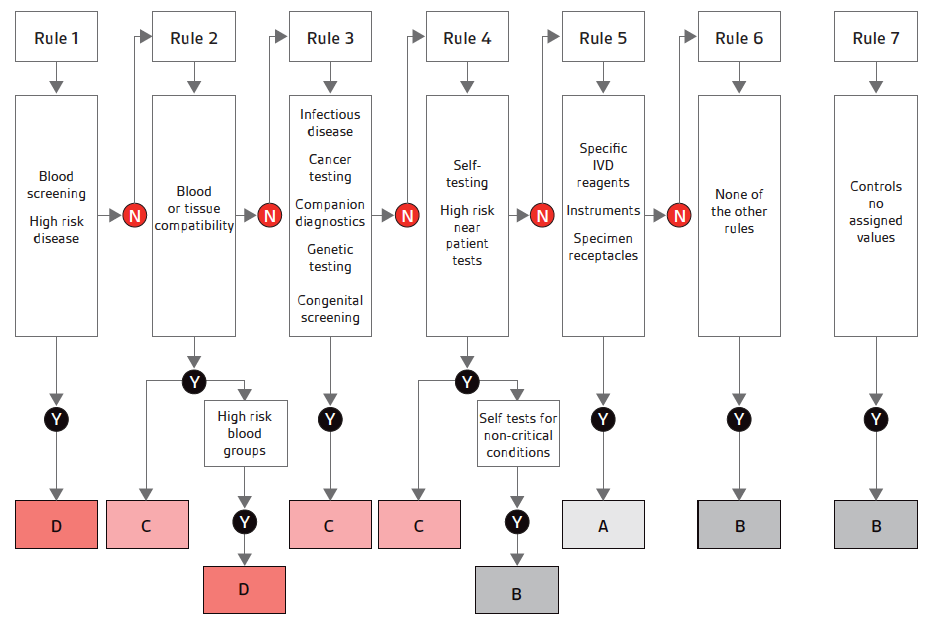The Regulation entered into force on May 26th, 2017, giving manufacturers five years to transition to the new IVD Regulation. The new rules will apply from May 2022 for IVD devices.
The main impact of the legal revision is that if a manufacturer is not compliant under the regulations in time it equals to no more placing products on the EU market. There-is-no-grandfathering. Every device must be phased into the new system and meet all new requirements that apply to it.
There are still a lot of uncertainties, like which Notified Body will be appointed for IVDR, as well as the timely designation of the reference labs. Although there are uncertainties, the deadline will not change, and neither does the fact that grandfathering is not allowed.

What is not uncertain, is the change in classification rules. The new rule-based classification system for products superseding the current list-based approach. It also means that a far larger number of IVD manufacturers require a Notified Body to certify their products, as classification rules are applied to all IVDs (see table below).
Under the IVD Directive, 90% if the industry could self-certify, but with the Regulation, up to 90% of the industry now requires a Notified Body.
In addition to the change in classification rules, there is increased harmony between the IVD Regulation and the equivalent Medical Device Regulation, including a focus on clinical performance evaluation, and increased control over the wider supply chain.
IVD manufacturers will also need to generate additional clinical and performance evidence for devices currently on the market in order to be able to transition them to the new regime implemented by the IVDR.
In addition, the administrative burden will increase substantially as a result of registration requirements and the transparency measures that build on the Unique Device Identification (UDI).
Manufacturers must take a proactive approach to the new regulation, plan, and budget for the transition of existing devices in a timely and detailed way, and allocate resources for this effort.
There are certain steps to follow:
1. Strategy discussion. See the blog of Dr. Gert Bos on why this is important for the IVD manufacturers.
2. GAP assessment.
Manufacturers will have to revisit all technical files and the quality system for all their devices currently on the market.

Want to know more about IVDR? Sign up for Qserve's Open Training: Fundamentals of the IVDR.
Common missteps in the preparation of technical documentation include:
- Poorly organized information;
- Lack of conclusions;
- Failure to update information (annually or state of art);
- Inadequate PMS;
- Inadequate risk management; and
- Communication with NB.
GAPS can be easily made transparent by a comparison between your existing technical documentation and the requirements of the IVDR. Qserve does have templates available and can explain to you how to use this for your files.
3. Portfolio rationalization
The GAP analysis shows the GAPS
for technical documentation and also QMS. For each GAP the remediation action should be determined. Based on costs versus revenues, together with the position in the product lifecycle, the manufacturer should decide if the device can be remediated, retired or stopped.
Important is the need to set up the end of life programs for the IVDs you retire. For this, it is obvious you have the latest info on the (soft) transition rules and possibilities that are seen now in the IVDR. Qserve has a lot of best practices, depending on device groups, technologies.
4. Notified Body communication
Early in the process, as part of the strategy discussion, it is advisable to make a risk assessment on your Notified Body, or if you do not have one yet have a selection process.
The current expectation is that there will be five to eight (5-8) medium size Notified Bodies with a large scope that will be designated for the IVDR and another similar size group of small Notified Bodies with
more specific scope. That is not a lot for the tidal wave of applications that will come their way. As mentioned, there is no grandfathering. Once more, every IVD needs to be reviewed by the Notified Body against the IVDR before you can continue to place it on the market after the transition period. This means that a constant dialogue with your Notified Body will be crucial to make sure that you have
mutual agreement on your deadlines.If you have never dealt with a Notified Body before, start doing that immediately to make sure you secure your place in the queue. Your QMS needs to be certified as well, it might be a good start to have your ISO audits done by the Notified Body of choice to make sure communication starts.
5. Post-market follow-up.
The IVDR will require much more in terms of structures than the IVD Directive, mostly in the field of post-market performance follow up, but also in the way the data is presented in your technical documentation.
Your current technical file structure will not be compliant under the IVDR, so there's significant work to be done there. Organizing all your self- certification technical files in an IVDR compliant set of technical documentation takes more time and effort than you might think.
Most IVDs are currently self-certified, so do not have a certificate, which means no soft transition for currently self-declared IVDs. This is a potentially massive bottleneck.
The IVDR has a link with EU legislation in the field of personal data, the General Data Protection Regulation (GDPR), which is applicable as of 25 May 2018. For IVD’s, many companies have samples lying around in their freezer. Is it allowed to use these samples? The GDPR is just as relevant for samples that are not left over. See Qserve's webinar and training on GDPR.
In case you wish to discuss your IVDR project with us, contact us.
Martin
You might also be interested in this blog: US FDA and EU IVDR diverging in regulatory approach towards genetic testing
Profile: